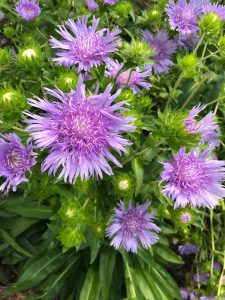
After a few years, many perennial plants have grown so large that they need to be divided in order to be revived. Overcrowding causes them to bear fewer flowers and, sometimes, to die in the center. Fall is a good time to divide perennials that bloom in spring and summer and are now done blooming for the year. This is a great way also to expand your perennial beds or share some of your perennial favorites with friends and neighbors.
Some examples of perennials to divide in the fall are:
Daylily, Hemerocallis spp.
Stokes’ aster, Stokesia laevis
Black-eyed Susan, Rudbeckia hirta
Yarrow, Achillea millefolium
Flax lily, Dianella tasmanica ‘Variegata’
Liriope, Liriope muscari
Cast iron plant, Aspidistra elatior

The first step is to dig out the entire clump. If there is enough clearance in the garden bed, start digging about six inches out from the plant and dig straight down beyond the root zone. It’s best to get as much of the roots as possible to lessen the shock of transplanting. If the clump is too heavy to remove, make your divisions right there with a sharp blade, trowel or shovel. Often, you can just pull them apart with your hands.
Before replanting the divisions, consider adding some nutritious compost to the planting beds to ensure healthy plants. Be sure to replant as soon as feasible to protect the roots from drying out. After replanting, water the transplanted divisions well and mulch appropriately.
For further information see:
Gardening with Perennials in Florida
Propagation of Landscape Plants
 0
0
